Exploring the Spectrum of Blue Crystals: Types and Uses
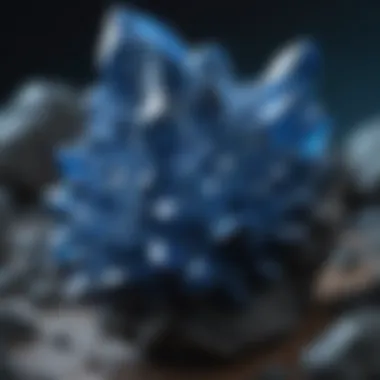
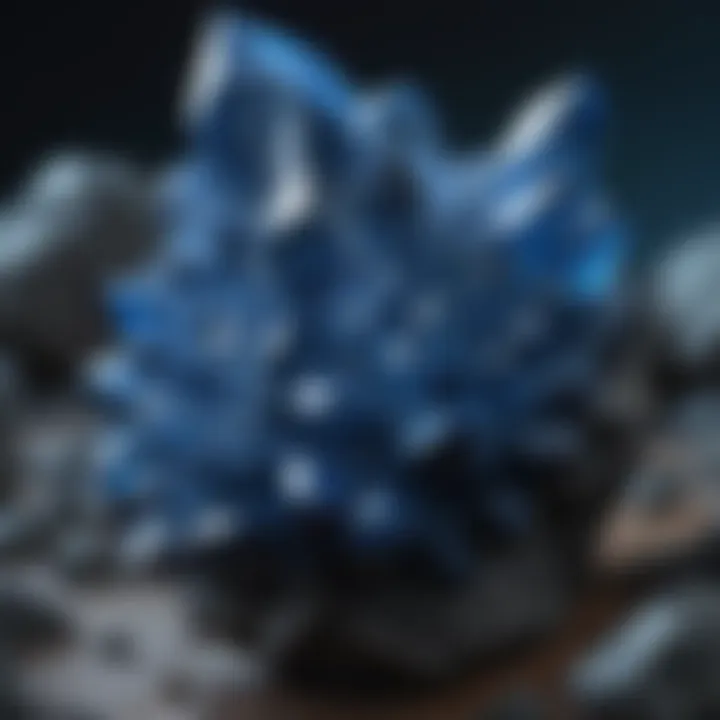
Intro
The world of blue crystals is both vast and enchanting, offering a stunning variety across the entire spectrum of hues and shades. From the deep, oceanic tones of lapis lazuli to the vibrant cerulean of blue topaz, these beautiful formations not only captivate the eye but often spark the curiosity of collectors, enthusiasts, and scientists alike. Their unique properties, origins, and applications make blue crystals a subject of intrigue, as they come with stories that stretch back through geological time and cultural history.
Exploring blue crystals can be akin to embarking on a treasure hunt. You will discover their geological formation methods, revealing how they are crafted by nature's hand deep within the Earth. The metaphysical significance attributed to many of these stones adds another layer, attracting those who seek to tap into their perceived powers. Collectors often find themselves drawn not just by the aesthetics, but also by the lore that various cultures have spun around these crystals throughout the centuries.
This guide will travel through the enchanting world of blue crystals, shedding light on specifics ranging from identifiable characteristics to resources that can enhance your collection or understanding. This comprehensive look aims to entice both seasoned collectors and those newcomers eager for knowledge.
Featured Collectible of the Month
Overview
This month, we spotlight Kyanite, a striking blue crystal renowned for its deep color and unique properties. Often found in metamorphic rocks, kyanite grows in a fibrous, elongated form, making it a favorite for both collectors and jewelers. Unlike most minerals, kyanite exhibits varying hardness levels depending on the direction, exhibiting a distinctive trait that’s just as fascinating as its color.
Historical Significance
Kyanite has a rich history. In various cultures, it was believed to bring balance and calm to its wearer. Chakras practitioners often use kyanite to promote communication and self-expression, attributing it to the throat chakra specifically. Furthermore, throughout history, it has been utilized as a talisman amongst indigenous tribes, who regarded its allure as both protective and sacred.
Identification Techniques
Visual Characteristics
Identifying blue crystals can sometimes feel like piecing together a complex puzzle. A collector needs to be attuned to subtle variations. Here are some key visual traits to keep in mind when identifying blue crystals:
- Color: The saturation and hue can indicate the specific type. For instance, aquamarine tends to be more pastel, while lapis lazuli supercharges deep, royal blue tones.
- Transparency: Some crystals, like blue topaz, are quite clear, whereas others like sodalite appear opaque.
- Internal Structure: The presence of unique inclusions or striations within the crystal can provide clues to its identity.
Resources for Identification
Whether you're a novice or a seasoned pro, having resources at your disposal can make all the difference. Here are some helpful tools and guides to consider:
- Books: Consider reading The Crystal Bible by Judy Hall, which features images and descriptions of various crystals.
- Online Communities: Websites like reddit.com have active communities where enthusiasts share identification advice and experiences.
- Local Gem Shows: Attending these can provide hands-on experience and access to knowledgeable sellers.
Through this exploration, you can deepen your appreciation of blue crystals, understanding their place not just in collections but also in the broader narratives of nature and culture. As each stone carries its own story, the journey of discovery resembles a winding path leading to new insights and connections.
Prologue to Blue Crystals
The allure of blue crystals captivates many—encompassing a range of hues and depths that mirror the natural world. In this section, we will explore what makes these gems not just wonderful to observe, but also significant in various spheres, from geology to metaphysics. Not only do blue crystals create stunning visual appeal, they embody rich histories and cultural meanings.
Among crystal enthusiasts and collectors, understanding blue crystals is essential for both appreciation and informed acquisition. These gems span from the accessible to the rare, each type possessing unique characteristics worth discussing.
Definition and Characteristics
Blue crystals are minerals that exhibit a blue hue due to their specific chemical composition and crystalline structure. This color can arise from trace elements such as iron, copper, or chromium, which create a spectrum of shades—from the softest sky blue of aquamarine to the deep, royal tones of lapis lazuli.
What sets blue crystals apart is not just their color but their varied forms and characteristics. For example:
- Aquamarine: Typically transparent, with a glassy luster, evoking the colors of the ocean.
- Sodalite: Often found with white veining, this stone appears in rich blue tones and has a more opaque quality.
- Blue Topaz: Famous for its clarity, often exhibiting bright and vibrant shades, sometimes enhanced by treatment.
These crystals possess different hardness levels on the Mohs scale, which affects their durability and suitability for various applications in jewelry or alternative therapies. Some blue crystals, like lapis lazuli, contain flecks of gold pyrite, further enhancing their aesthetic charm.
The Color Blue in Nature
Blue, being one of the rarest colors in nature, often symbolizes depth, wisdom, and tranquility. Nature offers a brief lesson here; looking closely, blue appears in spectacular ways—such as the vivid sky, vast oceans, or delicate flowers like the Evolvulus, also known as trailing bluebell.
The rarity of blue can be likened to its scarcity in the mineral kingdom. Many gems, such as sphene or kyanite, display mesmerizing blue shades that provide insight into their formation processes and environmental conditions where they originated.
"In nature, blue serves as a reminder of a serene and calming influence, underscoring its significance across cultures and disciplines."
Understanding the role and meaning of blue in nature enhances our appreciation for these crystals, their formation, and their journey from earth to the hands of collectors. This examination sets the stage for further exploration into specific types of blue crystals in the following sections.
Geological Formation of Blue Crystals
Understanding the geological formation of blue crystals is crucial for both collectors and enthusiasts. It dives into how these stunning pieces of nature come to be, revealing not just their aesthetic appeal, but also their rarity and significance. This section aims to illuminate key aspects such as mineral composition and the crystallization process, offering perspective on how environmental factors and geological shifts create various types of blue crystals.
Mineral Composition
The mineral composition of blue crystals is an essential consideration in their study. Each blue crystal is made up of specific minerals that disturbate its color, clarity, and overall characteristics. For example, aquamarine is primarily composed of beryl, while lapis lazuli consists mainly of lazurite along with calcite and pyrite, giving it its rich blue hue.
- Beryl: A group of minerals that includes aquamarine and emerald; the presence of iron and other trace elements can also affect the color intensity.
- Lazurite in lapis lazuli: This sulfosilicate mineral contributes to the deep blue color, complemented by golden flecks of pyrite.
- Cordierite: Found in iolite, this mineral has a distinctive pleochroism, meaning that the color can change when viewed from different angles.
Analyzing the mineral composition sheds light on the conditions under which these crystals formed, thereby enhancing their value and appeal. Collectors often seek specific minerals or compositions, knowing the uniqueness that each brings to their collection.
Crystallization Process
The crystallization process is another vital aspect of how blue crystals are formed. This involves the transition of a substance from a gaseous or liquid state into a solid formation, where the atoms and molecules organize themselves in a highly ordered structure. Environmental conditions greatly influence this transformation.
- Temperature and Pressure: Changes in these factors can affect how the crystals grow. For instance, aquamarine typically forms in granite pegmatites, where the right combination of heat and pressure allows beryl to crystallize.
- Cooling Rate: A slower cooling rate usually allows larger crystals to develop. Rapid cooling can lead to smaller, more chaotic formations.
- Composition of the Surrounding Environment: The presence of minerals and other elements determines not only the size of the crystals but also the purity and quality.
- Time: The length of time a crystal has to grow can also impact its development. Some blue crystals, like tanzanite, take millions of years to form under the earth's surface.
The crystallization of blue crystals is as much an art as it is a science, influenced by earth's intricate dances of heat, pressure, and time.
The understanding of how these crystals come into being carries implications for their collection and investment potential. Enthusiasts should appreciate the longstanding natural processes behind these beautiful formations, recognizing that a well-informed collector can truly value a crystal, not just for its visual allure but for its intricate history.
Common Types of Blue Crystals
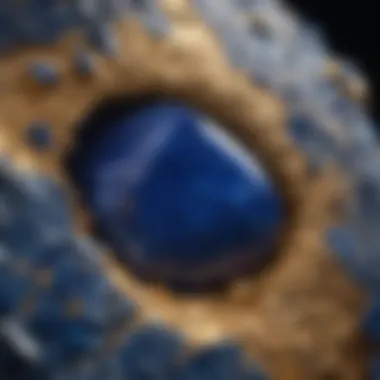

Blue crystals captivate collectors and enthusiasts alike, not just for their stunning hues, but also for their unique qualities and historical significance. Each type presents its own story, possessing distinct features that make them valuable in various ways. Understanding these common types serves as a foundational element for anyone delving into the world of blue crystals. It's about appreciating not only their beauty but also their characteristics, uses, and origins.
Aquamarine
Origin
Aquamarine, with its serene blue shades, originates primarily from Brazil, Nigeria, and Pakistan. This crystal gets its name from the Latin word for seawater, reflecting its turquoise nature. Its connection to water is deep-rooted, often associated with calmness and tranquility. Many treasure this crystal for its historical use in navigator's protection during voyages. This origin gives it a unique appeal, particularly among those who seek connection to the sea. One downside, however, is that mining practices can impact both quality and environmental aspects
Properties
When we talk about the properties of aquamarine, clarity often comes to the forefront. Typically, these crystals are translucent to transparent, making them desirable in jewelry. They are primarily composed of beryl, which contributes to their durability. Collectors appreciate that aquamarine maintains its dazzling appearance even after years of wear. But, its softer nature can also make it susceptible to scratches if not cared for properly.
Uses
In terms of uses, aquamarine shines in jewelry and healing practices. Many believe it helps alleviate stress and promotes emotional clarity. The affinity for craftsmanship makes it a popular choice among jewelers who create everything from rings to pendants. However, the allure of aquamarine can come at a price, sometimes steering novice collectors away due to its cost.
Sodalite
Origin
Sodalite, primarily found in Canada, Brazil, and Namibia, showcases a unique blend of blue and white hues, giving it a distinctive look. Its origin can be traced back to the late 19th century, where it was primarily used as an ornamental stone. The geological background makes it a favorite among rockhounds. Unlike rarer stones, sodalite is more abundant, making it a good starting point for new collectors. Still, frequent treatments used to enhance color can mislead novice buyers.
Properties
Famed for its rich deep blue color, sodalite often contains white streaks, which make each piece unique. Its properties include a relatively low hardness, sitting around 5.5 to 6 on the Mohs scale, which means it requires some care to maintain its luster. Collectors enjoy its lightweight nature, allowing for easy handling. Yet, this softness also makes it prone to chips and fractures if not handled with care.
Uses
Sodalite is popularly used in jewelry and decorative items. Due to its association with logic and intuition, many turn to it for meditation and mindfulness practices. It’s not just a pretty stone; it’s said to help promote intellectual abilities. However, its somewhat low value can make it less appealing for serious investment.
Blue Topaz
Origin
Blue topaz is widely sourced from regions like Brazil, Nigeria, and Pakistan. These origins tie closely to the gem’s vibrant clarity and brilliance. Sometimes mistaken for other stones, natural blue topaz is relatively rare, with most found being heat-treated or irradiated to achieve the desired hue. Its origin story adds depth, appealing to collectors who value authenticity. However, the prevalence of treatments can confuse those newer to collecting.
Properties
Among its properties, blue topaz is celebrated for its vivid blue shades and exceptional clarity. It typically registers between 8 on the Mohs scale, making it a robust option for daily wear. This resilience blends well with buyers looking for beauty without compromising durability. Yet, many collectors must be wary of man-made imitations flooding the market.
Uses
As for uses, blue topaz shines in both fashion and wellness. Beyond its role in jewelry, where it symbolizes strength and wisdom, it’s used in some healing practices known to promote self-control. Despite being widely available, it commands attention for its beauty, aiding in its understated investment value.
Lapis Lazuli
Origin
Earning its reputation since ancient civilizations, lapis lazuli primarily comes from Afghanistan, though deposits can also be found in Chile and Russia. Its historical usage as a pigment in art and decoration enhances its allure today. The historical richness linked to lapis makes it a favorite among serious collectors. However, its increasingly rare top-quality forms are becoming scarcer, escalating both value and competition among collectors.
Properties
The deep, celestial blue, accented by golden flecks of pyrite, sets lapis lazuli apart. Known for its deeper symbolism connecting to kings and royalty, its properties span emotional healing and wisdom. The unique intermingling of colors gives each piece a story. Its softness at a 5 to 6 on the Mohs scale does make it easier to damage, prompting careful handling.
Uses
Lapis lazuli finds a home in both ornamental and spiritual contexts, being used in jewelry but also serving as a meditation stone. Many believe it to amplify intellectual ability, which adds to its desirability. Still, its price can be prohibitive for newer collectors, necessitating careful selection.
Iolite
Origin
Iolite, often called the "water sapphire", primarily hails from Madagascar, India, and Brazil. Its name derives from the Greek word for violet, yet it embodies vibrant shades of blue. As a metaphysical stone, it resonates with the concept of navigating through one’s life challenges. Its multiple hues can illuminate a collector's journey, but the gem’s softness can detract from its durability; this needs careful consideration.
Properties
Iolite is known for its color-changing properties; under different lighting, it can reveal hues from blue to violet. This optical phenomenon isn’t just beautiful but adds layers of intrigue. With a Mohs hardness of 7 to 7.5, iolite offers a balance between beauty and practicality, although that can vary significantly between natural and synthetic varieties.
Uses
In usage, iolite is favored in jewelry for its unique color characteristics, well sought after by many collectors aiming to enhance their collection. Moreover, it’s often cited in healing practices, believed to aid in decision-making and inner vision. Despite this, market fluctuations tend to impact its value significantly, leaving it somewhat uncertain as an investment.
Rare Blue Crystals
The world of blue crystals is an enchanting realm filled with unique gemstones, each bringing its own story and characteristics. Rare blue crystals, in particular, capture not only the eyes of collectors but also the hearts of enthusiasts. These gems often remain elusive, making their discovery and acquisition worthy of note for any serious collector. Rarity contributes significantly to the value and allure of these crystals, quite similar to finding a needle in a haystack. The focus on rare specimens elevates a collector's status, as possessing such gems is often seen as a badge of honor.
Tanzanite
History
Tanzanite is a relatively recent addition to the family of gemstones, first discovered in the 1960s near Mount Kilimanjaro in Tanzania. The unique feature of this crystal, its rich blue and violet hues, immediately caught the attention of gem enthusiasts and jewelers alike. The history of tanzanite is not just about its discovery; it also involves the struggle for commercial acceptance in a market dominated by long-established gemstones. Its relatively short history makes it a compelling choice for collectors who appreciate stories behind the pieces. Moreover, tanzanite's discovery came at a time when colored gemstones began to surge in popularity, providing a fresh narrative that elevates its value in the eyes of buyers and investors.
Significance

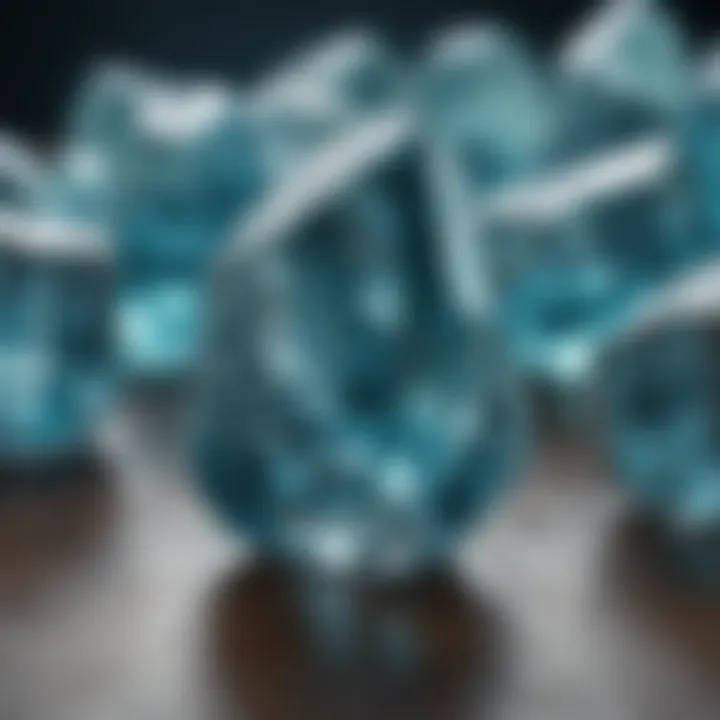
The significance of tanzanite lies not just in its rarity but also in its vibrant colors and metaphysical properties. Symbolically, it is linked with transformation, and many believe that it helps promote a deeper understanding of oneself. This characteristic makes tanzanite much more than just a decorative stone; it appeals to those seeking emotional growth. The allure of its multifaceted colors, shifting between blue and violet depending on the angle of light, adds to its cultural significance. Collectors often find themselves drawn to tanzanite not just because of its beauty but also its reputed spiritual implications.
Market Trends
In recent years, market trends for tanzanite have shown fluctuations based on supply and demand. The ongoing mining challenges in Tanzania add a layer of complexity, limiting the crystal’s availability and pushing its market value upwards. Furthermore, tanzanite’s presence in high-end jewelry has led to a steady rise in demand. However, collectors should proceed with caution—fickle market conditions can lead to price volatility. Overall, understanding these trends can empower collectors to make informed decisions about their investments in tanzanite.
Kyanite
Occurrence
Kyanite is an interesting crystal that occurs in a variety of geological environments, typically found in metamorphic rocks. This crystal often shows up in locations such as Brazil, Kenya, and the United States, leading to a diverse array of samples for collectors. Its distinct characteristic is the varying hardness based on its crystallographic orientation—this can create challenges when cutting and polishing kyanite. For collectors, the uniqueness of kyanite’s occurrence, combined with its visual appeal, makes it a valuable addition to any collection. However, one must consider that kyanite is often not as widely recognized as other blue stones.
Properties
When discussing the properties of kyanite, one must highlight its striking blue color, often with fibrous texture. This particular feature not only makes it visually appealing but also affects its pricing and desirability. Unlike some other blue crystals, kyanite is not typically treated, thus retaining its natural allure. Purists appreciate its authenticity and prefer kyanite in its raw form. This can lead to distinctive pricing variances, making it a topic of interest among dedicated collectors.
Uses
Kyanite is celebrated both for its aesthetic qualities and metaphysical properties. The crystal is often utilized in various metaphysical practices, believed to facilitate communication and mental clarity. Its rarity in jewelry, paired with its unique formation processes, makes it a sought-after piece for collectors who delve beyond superficial beauty. Although kyanite is not primarily used in mainstream jewelry, its niche market has emerged, appealing to those who seek uniqueness and spiritual connection.
Blue Zircon
Origin
Blue zircon is a natural gemstone that often gets confused with cubic zirconia; however, it is important to note that they are entirely different. The origin of blue zircon dates back to the 19th century when this gemstone was first recognized for its beauty and brilliance. Found primarily in countries like Cambodia and Sri Lanka, the crux of blue zircon lies in its zirconium silicate composition. Its origins play a significant role in determining quality, with the best specimens coming from these geological hotspots. Collectors value blue zircon for its breathtaking brilliance and remarkable fire, setting it apart from its synthetic counterparts.
Properties
The properties of blue zircon make it an exceptional gemstone. Its notable hardness ranks it high on the Mohs scale, meaning it's durable and less prone to scratches. The crystal flourishes in varying shades of blue, sometimes exhibiting even more than one hue in a single specimen. Such characteristics render blue zircon a popular choice for jewelry design. However, it requires a discerning eye as heavier treatments can diminish its value, making authenticity a primary focus for serious collectors.
Market Value
In terms of market value, blue zircon has fluctuated over the years, often driven by trends in the jewelry industry. Unlike more popular stones, blue zircon sometimes gets overlooked, providing unique opportunities for savvy investors. The relative scarcity compared to more common gemstones contributes to its allure but can also lead to price unpredictability. Thus, while it holds substantial potential, collectors must navigate the waters carefully to ensure they are acquiring pieces that will grow in value over time.
Metaphysical Properties of Blue Crystals
The metaphysical properties of blue crystals have long captivated both casual enthusiasts and seasoned collectors alike. These crystals are believed to hold energies that can positively influence emotional states and promote physical healing. Exploring these facets unveils the deeper connections that can exist between humans and their natural surroundings. Understanding their benefits can enrich one’s experience, be it for personal growth or for offering supportive guidance alongside various healing practices.
Healing Properties
Emotional Health
When it comes to emotional health, blue crystals are often associated with calmness and serenity. Crystals such as lapis lazuli and aquamarine are considered powerful allies for those feeling overwhelmed or stressed. Their vibrations help to clear the mind and encourage open communication. This ability to foster emotional clarity makes them a favored choice among many seeking peace in tumultuous times.
A unique characteristic of the emotional health aspects of blue crystals is the throat chakra connection. This chakra is crucial for expression. Therefore, blue crystals play a key role in opening channels for communication, allowing individuals to articulate their feelings more effectively. However, it’s essential to remember that these crystals are not magic solutions; instead, they work synergistically with individual efforts toward mental wellbeing.
Physical Healing
Physical healing is another facet where blue crystals shine, with stones like blue kyanite and sodalite being praised for their purported healing properties. Their influences extend to relief from ailments, particularly those related to the throat and respiratory system. Like the other healing aspects, physical benefits often require a bit of patience.
One of the most compelling characteristics of physical healing properties in blue crystals is their potential to enhance overall detoxification processes. While some may find these claims too good to be true, many who have integrated them into their wellness routines report noticeable improvements in their health. The main drawback lies in the subjective nature of these experiences; what aids one might not necessarily work for another.
Meditation and Mindfulness
Techniques
Blue crystals can be powerful tools in meditation and mindfulness practices. By incorporating them into daily routines, practitioners aim to enhance focus and spiritual awareness. Using crystals during meditation can foster a deeper connection to one’s intentions, as they are believed to amplify energies. Many recommend placing a crystal like blue topaz on one’s body while meditating to create a calming atmosphere.
This technique is notable for its simplicity—it requires no special skills or elaborate setups. Simply holding a crystal or placing it nearby can create a conducive space for mindfulness. However, it’s essential not to get overly fixated on the crystals themselves; they are merely aids rather than the centerpieces of the practice.
Benefits
The benefits of using blue crystals in meditation extend beyond the immediate experience, fostering long-term mental clarity and emotional stability. Regular meditation with blue stones can lead to enhanced creativity and improved decision making—attributes valued by many.
A key feature of these benefits is the management of anxiety and stress, which far too many contend with today. By integrating blue crystals into meditation, practitioners report a more profound sense of ease and relaxation. Nevertheless, it’s critical for individuals to remain cautious and aware; crystals should not be relied upon solely for emotional or mental health solutions.
"The magic of blue crystals lies not just in their physical beauty, but in their deep spiritual connections that resonate with our inner experiences."
In summary, the exploration of blue crystals within the realms of emotional and physical healing, as well as meditation practices, reveals the intertwined nature of their metaphysical properties. Developing a deeper awareness of these elements can substantially enrich the experiences of those seeking balance and harmony in their lives.
Care and Preservation of Blue Crystals
When it comes to blue crystals, the importance of care and preservation cannot be stressed enough. These stunning formations, while beautiful, require attention to maintain their luster and integrity. Proper handling ensures not just the appearance of the crystals, but also their longevity. Whether you are a seasoned collector or just beginning your journey, taking steps to preserve your blue crystals serves to enhance both their beauty and value over time.
Cleaning Techniques
Cleaning blue crystals isn't just a routine task; it's a crucial step in their upkeep. Different types of crystals have unique properties and susceptibility to damage from harsh cleaning methods. Here are several effective cleaning techniques suitable for a variety of blue crystals:
- Gentle Soap and Water: For most blue crystals like aquamarine and lapis lazuli, a mixture of mild soap and lukewarm water is generally safe. Use a soft brush or cloth to gently scrub the surface.
- Avoid Harsh Chemicals: Always steer clear of abrasive cleaners or those with high acidity, as they can eat away at the natural surface.
- Rinse and Dry Thoroughly: After cleaning, ensure to rinse the crystals under cool running water to remove any soap residue. Dry them carefully with a soft, lint-free cloth.
- Steam Cleaning: For the more resilient varieties like blue topaz, steam cleaning can effectively remove dirt without damaging the stone. However, use this method cautiously and avoid it for softer crystals.
"Proper cleaning can breathe new life into your cherished crystals, revealing their vibrant hues once more."
Storage Recommendations
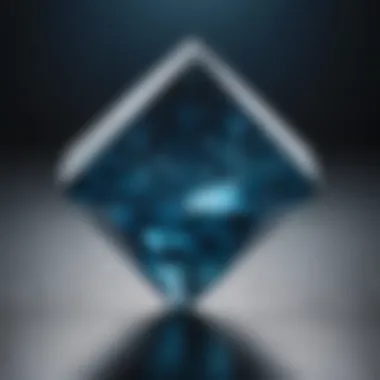
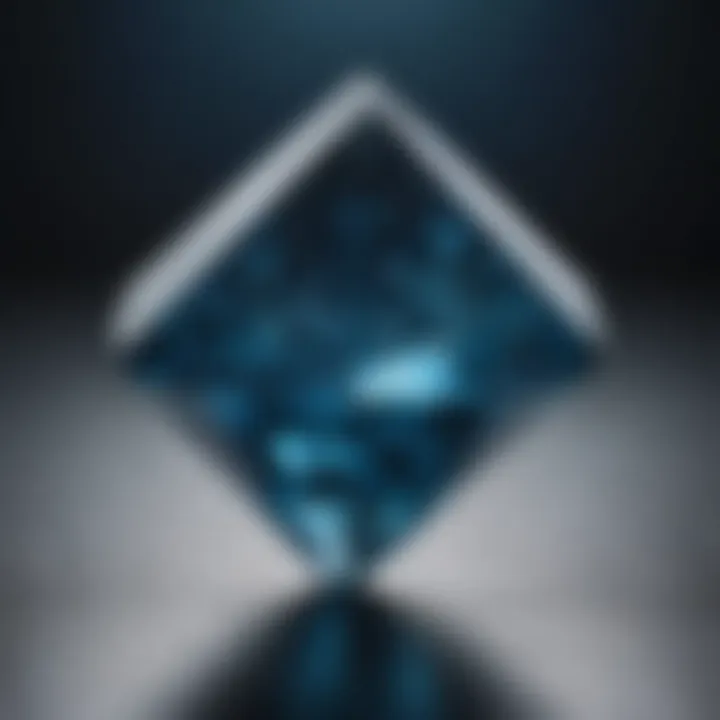
Storing blue crystals properly is just as essential as cleaning them. Improper storage can lead to scratches, chips, or even significant damage. Here are key recommendations for ensuring the safe storage of your blue crystals:
- Individual Containers: Ideally, store each crystal in its own container, such as a soft pouch or a dedicated display box. This prevents them from touching one another and protects them from accidental damage.
- Temperature Control: Keep the crystals in a climate-controlled environment. Extreme heat or humidity can cause certain types of crystals, like blue Zircon, to degrade.
- Avoid Direct Sunlight: Prolonged exposure to sunlight can fade the color of some crystals. A dark or shaded location is preferable for long-term storage.
- Regular Checks: Periodically inspect your collection for any signs of damage or wear. This proactive approach can help in catching potential issues early on.
By following these cleaning techniques and storage recommendations, you not only keep your blue crystals looking their best but also ensure they can be enjoyed for years to come. Fostering a sense of responsibility toward these exquisite creations connects collectors to the deeper beauty they encapsulate in our natural world.
Collecting Blue Crystals
Collecting blue crystals opens up a fascinating realm for enthusiasts and collectors alike. The allure of these striking gems lies not only in their vibrant colors but also in their unique characteristics and the stories behind them. This section will delve into the nuances of starting a collection, the resources available for beginners, and understanding the market value of these beautiful treasures.
Starting a Collection
Choosing Your First Crystals
Choosing your first crystals can feel a bit like picking out a pet; you want to ensure that you find one that complements your lifestyle and interests. Opting for widely recognized and relatively easy-to-find crystals, like aquamarine or blue sodalite, provides a solid foundation for your collection. These crystals are not only stunning but symbolize serenity and trust, making them daily popping reminders of calmness embedded in your living space.
The key characteristic here is availability. Many local shops or online outlets have a regular supply of these types of crystals, making it easier for novice collectors to start their journey. However, one must also consider that more accessible crystals can sometimes be less valuable in the market, leading to a collection that might grow rapidly but lacks the unique spark that rare pieces hold.
In the end, the advantages of choosing crystals like aquamarine are the ease of finding them, while the disadvantage might be their market saturation.
Resources for Beginners
Resources for beginners are abundant, thanks mostly to the digital age. Websites and forums like Reddit's crystal collecting community and specialized Facebook groups provide ample information on where to find crystals, proper care techniques, and insights on various types.
An essential feature of these resources is their accessibility. Whether you're sitting at home or on the go, a quick search can yield myriad blogs and videos that illustrate everything from the geological formation of these crystals to their healing properties. The downside, though, is the overwhelming quantity of information available. Sorting through it to find credible sources sometimes requires more time and effort.
These resources can serve as a compass when navigating the vast sea of crystal collecting.
Market Value and Investment
Evaluating Worth
Understanding how to evaluate the worth of blue crystals is crucial for any serious collector. Factors such as clarity, cut, color, and carat can impact the value significantly. Additionally, rarity plays a pivotal role; a deep blue tanzanite, for example, can command a much higher price than a common light blue topaz.
The ability to discern these elements not only helps in building a valuable collection but also aids in making informed buying decisions. However, the challenge here lies in the subjectivity of beauty and value—it can change based on current market trends and personal preferences. Thus, collectors should also be cautious of fluctuating prices dictated by fads.
Trends in Blue Crystals
Keeping a finger on the pulse of trends in blue crystals can be essential for those looking to invest wisely. Currently, there seems to be a growing interest in ethically sourced and sustainable crystals. More collectors are keen on understanding the origin of their pieces and are willing to pay a premium for those that come with a credible story.
A unique aspect of this trend is its reflection on consumer behavior—people are becoming more conscientious about their purchases, often gravitating towards crystals that resonate with environmental values. However, this shift can sometimes lead to inflated costs, particularly for sought-after ethical items. It’s essential for collectors to weigh these market dynamics against their personal goals for collecting.
Exploring Cultural Significance
The realm of blue crystals is not just a study in geology and mineralogy; it weaves a rich tapestry of human culture across centuries and continents. Understanding their cultural significance unlocks an appreciation for these natural wonders that goes beyond their physical allure. Throughout history, blue crystals have been associated with deep meanings, serving as symbols of power, spirituality, and identity in various societies.
The importance of exploring this cultural significance lies in recognizing how these gems have influenced art, tradition, and even beliefs in communities. Each crystal carries its own story, reflecting the values and beliefs of those who prized them. By diving into this subject, enthusiasts gain a rounded perspective on the emotional and historical weight carried by blue crystals.
Historical Uses of Blue Crystals
The historical relevance of blue crystals reveals their multifaceted roles across different ages and civilizations. For instance, lapis lazuli was highly sought after in ancient Egypt, often ground into powder for use in cosmetics and art. Its radiant blue hue was a symbol of the heavens, frequently adorning the tombs of pharaohs, further reinforcing its sacred status.
In other cultures, blue quartz found its place in the lap of royalty. Used as a talisman, it was believed to deter harm and promote inner peace. Similarly, ancient Greeks valued sodalite for its ability to foster rational thinking and tranquility. Many philosophers would carry it, seeing it as an aid for sound decision-making.
Additionally, Iolite was often used as a navigation tool by Vikings, who utilized thin slices of this stone to locate the sun on cloudy days. This practical use underscores how blue crystals have not only inspired artistic expression but also practical solutions in challenging times.
Symbolism in Various Cultures
The symbolism attributed to blue crystals varies widely across cultures, reflecting diverse spiritual beliefs and practices. In many Native American traditions, blue stones are viewed as protective talismans. They are said to carry the power of the sky and the sea, often used in ceremonial rituals to invoke strength and harmony.
Moreover, in Eastern traditions, the color blue represents tranquility and healing. Blue topaz, for example, stands for wisdom and serenity, associated with balance and communication. It’s commonly incorporated into jewelry worn during meditation or prayer, symbolizing a connection to higher realms.
There’s also a fascinating interplay of superstitions surrounding blue crystals. In some cultures, it’s believed that wearing blue stones can attract prosperity and good fortune. Conversely, certain communities might perceive these stones as carriers of negative energy if mishandled.
Ultimately, these cultural interpretations enrich the understanding of blue crystals, making them not just objects of beauty but also reservoirs of human beliefs and experiences. By recognizing this, collectors and enthusiasts alike can foster a deep, personal connection with their specimens.
The End
As we reach the end of our journey through the realm of blue crystals, it's clear that these stunning natural wonders weave intricate narratives about our planet and its history. The importance of blue crystals cannot be overstated; they are not only visually captivating but also hold significant geological, cultural, and metaphysical value.
Recap of Key Points
In reviewing the key elements covered in this article, we see a well-rounded discussion about a variety of blue crystals ranging from the popular aquamarine to the more elusive tanzanite.
- Geological Formation: We delved into how these crystals are created through mineral compositions and crystallization processes that take place over millennia.
- Common and Rare Types: Each crystal type showcases its uniqueness, from the common blue topaz found in jewelry to the rare blue zircon, sought after by collectors.
- Metaphysical Properties: The significance of blue crystals in emotional and physical healing has been explored, resonating with many who prioritize mindfulness.
- Cultural Significance: We captured how various cultures have valued and utilized blue crystals, adding depth to their historical context.
The insights are not just for the enthusiast; collectors and investors gain from understanding the fluctuations of market values and the trends they encapsulate.
Future of Blue Crystal Collecting
Looking ahead, the future of blue crystal collecting appears bright. With increasing awareness and appreciation for natural gemstones, more individuals are drawn to the unique characteristics each variety possesses. From aesthetic appeal to potential investment value, blue crystals offer opportunities for both beauty and financial growth.
Here are a few considerations for collectors:
- Research: As with any investment, understanding the market is crucial. Keep an eye on trends in availability and pricing.
- Networking: Engaging with fellow collectors and joining communities online, such as forums on Reddit or Facebook groups, can provide valuable information and camaraderie.
- Sustainability: Increasingly, collectors are becoming more conscientious about sourcing crystals ethically. This not only protects the environment but also ensures that future generations can enjoy these natural treasures.
"Collecting blue crystals is more than a hobby; it's a deep dive into the earth's history, art, and healing properties wrapped in a stunning blue hue."
The eight segments we have explored together illuminate not only the allure of blue crystals but also emphasize the importance of responsible collecting practices.



